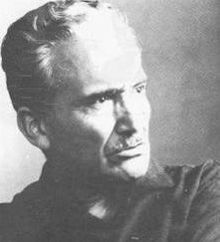José María Arguedas facts for kids
José María Arguedas Altamirano (born January 18, 1911 – died December 2, 1969) was a famous Peruvian writer and anthropologist. He wrote many novels, short stories, and poems.
Arguedas was from a Spanish family, but he learned to speak the Native Quechua language very well. He lived with two Quechua families when he was young, from age 7 to 11. This helped him understand their culture deeply. He wrote his books in both Spanish and Quechua.
People remember Arguedas as one of the most important writers in Peru during the 1900s. He was especially good at showing what Indigenous Andean culture was like. To make his stories feel more real, he created a new way of writing that mixed Spanish and Quechua words. He first used this style in his book Yawar Fiesta.
Even though not many of his books have been translated into English, some critics say he was a very powerful writer.
Contents
Life Story of José María Arguedas
José María Arguedas was born on January 18, 1911, in Andahuaylas, a place in the southern Peruvian Andes mountains. His family was well-off, but his mother passed away when he was only two years old.
His father was a lawyer who traveled a lot, so Arguedas often felt alone. He also had a difficult time with his step-mother and step-brother. He found comfort with the Indigenous people who worked for his family. This helped him learn their language and customs, which became a big part of who he was.
He went to primary school in different towns like San Juan de Lucana, Puquio, and Abancay. He finished his high school studies in Ica, Huancayo, and Lima.
His Studies and Work
In 1931, Arguedas started studying at the National University of San Marcos in Lima. He earned a degree in literature. Later, he studied Ethnology, which is the study of different cultures. He got his degree in ethnology in 1957 and his doctorate (a higher degree) in 1963.
Between 1937 and 1938, he was put in prison. This happened because he protested against a visitor from Italy's leader, Benito Mussolini.
Arguedas also worked for the Ministry of Education. He used this job to help save and share Peruvian culture, especially traditional Andean music and dance. He was in charge of the Casa de la Cultura (House of Culture) in 1963 and the National Museum of History from 1964 to 1966.
In 1968, Arguedas received a special writing award called the Inca Garcilaso de la Vega prize. When he accepted it, he gave a famous speech called No soy un aculturado (which means "I am not a man who has lost his culture"). In this speech, he proudly talked about his mixed background.
Later Life and Passing
Arguedas faced challenges with his mental health, and his depression became very serious in 1966. To help himself, he talked to a psychiatrist who suggested he keep writing. Following this advice, he published another book of short stories called "Amor Mundo." He also started working on his last book, The Fox From Up Above and the Fox From Down Below.
The title of this book comes from an old Quechua story that Arguedas had translated. "El zorro de arriba y el zorro de abajo" (The fox from up above and the fox from down below) are symbols in Quechua for things like life and death, or old traditions and new ways.
José María Arguedas passed away on November 29, 1969. He left behind detailed instructions for his funeral, a diary about his struggles with depression, and his final book, The Fox From Up Above and the Fox From Down Below, which was not quite finished.
Arguedas's Writing Career
Arguedas started his writing journey by creating short stories. These stories were about the Indigenous world he knew so well from his childhood. He wrote in a unique Spanish style that was greatly influenced by Quechua syntax (how words are put together) and vocabulary (the words themselves).
When his first novel, Yawar Fiesta ("Blood Fest"), came out in 1941, he began to explore a main idea that would stay with him: the differences between modern "Western" ways and the traditional Indigenous way of life. Because of this, he was part of the indigenista movement in South American literature. He continued to write about this idea in his next two books, Los ríos profundos ("Deep Rivers," 1958) and Todas las Sangres ("All the Bloods," 1964).
Arguedas wanted to give Andean Indigenous people a real voice in his books. He tried hard to show their true experiences, not just simple ideas about them. Some people felt that he sometimes made Indigenous characters seem too gentle or childlike. Another important idea in his writing was the struggles of mestizos—people who have both Indigenous and Spanish backgrounds—and how they tried to live with both parts of their identity. Many of his stories also showed the unfair treatment and challenges faced by different groups in Peru's small towns and farms.
At first, Arguedas was hopeful that traditional ways and modern ways could come together. But by the 1960s, he became less optimistic. In his last book, El zorro de arriba y el zorro de abajo ("The Fox From Up Above and the Fox From Down Below," 1969), he changed his writing style. This book showed his sadness and fear that the old ways of the Indigenous people might not survive against new technology and modern business.
Around this time, some younger Peruvian thinkers started to criticize his work. They felt his writing about Indigenous and rural life was too poetic or romantic. For example, in 1965, there was a famous discussion called Mesa redonda sobre Todas las Sangres (Roundtable on All the Bloods), where his second-to-last novel was openly discussed by several social scientists.
See also
 In Spanish: José María Arguedas para niños
In Spanish: José María Arguedas para niños
- Peruvian literature


